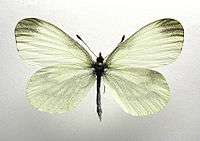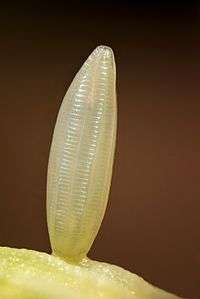Leptidea sinapis
| Wood white butterfly | |
|---|---|
_P.jpg) | |
| Kampinos Forest, Poland | |
| | |
| Sennwald, Switzerland | |
| Scientific classification | |
| Kingdom: | Animalia |
| Phylum: | Arthropoda |
| Class: | Insecta |
| Order: | Lepidoptera |
| Family: | Pieridae |
| Genus: | Leptidea |
| Species: | L. sinapis |
| Binomial name | |
| Leptidea sinapis (Linnaeus, 1758) | |
Leptidea sinapis, the wood white, is a butterfly of the Pieridae family.
Distribution and ecology
It is found in Europe and eastwards across the Caucasus, Asia Minor, the Middle East, Middle Asia, Kazakhstan and south Siberia to the Baikal region.
Geographical variation is slight but the following subspecies are recognized:
- L. s. sinapis (Linnaeus, 1758) Sweden, western Siberia, the southern Altai
- L. s. pseudodiniensis (Pfeiffer, 1927) the Caucasus, Kopet-Dagh
- L. s. melanoinspersa Verity, 1911 western and northern Tian-Shan, Dzhungarsky Alatau, Alay Mountains
- There is an uncertainly ranked form from Darvaz.
The insect is found in meadows, forest edges and sparse forests up to 2,500 m above sea level. The adult flies from April to October in two, sometimes three, generations. Host plants in Europe (Eckstein, 1913; Lorkovic, 1947; Ebert, 1991: Fabaceae) are Lathyrus pratensis, Lotus corniculatus and Vicia species.
Similar species

Leptidea sinapis is one of three species in a cryptic species complex. The other members are L. reali and L. juvernica.[1] Similar species are L. morsei L. duponcheli and L. amurensis.
British Isles
Once a common and widespread butterfly across the southern half of the UK, this species has seen a drastic decline over the past 150 years. It is now found only in a few scattered colonies in Herefordshire, Worcestershire, Northamptonshire, Buckinghamshire, Devon, Surrey and Somerset. Until 2001, wood whites were thought to be much more common and widespread in Ireland than in England and were thought to be expanding their range there. However, it was discovered that the vast majority were the almost identical species Réal's wood white (L. reali). L. sinapis is only found in the Burren region in the west of Ireland. Then in 2011 L. reali was itself split into two species and all those occurring in Ireland (except for the Burren insects) were reclassified as the cryptic wood white L. juvernica. It is Britain's smallest and rarest white butterfly and has a slow, delicate flight. Rarely, if ever, this species can be seen on treeless, unforested areas. The upperside is white with greyish tips to the forewings but they never settle with their wings open. The underside is a pale greyish green and serves as a good camouflage when settled. It has one main flight period in a season, late may to June but in warm summers a partial second shorter one occurs in August.
Life history
The female lays her eggs on various members of the pea family in late May and June, most commonly meadow vetchling (Lathyrus pratensis), bitter vetch (Lathyrus linifolius), tufted vetch (Vicia cracca) and birds-foot trefoil (Lotus corniculatus). The larvae are green and well camouflaged on their food plant. Pupation takes place at the end of July in surrounding scrub and it is this stage which overwinters.

References and external links
- Jim Asher et al. The Millennium Atlas of Butterflies of Britain and Ireland Oxford university press
- David Tomlinson & Rob Still Britain's Butterflies Wild Guides
- Wood White page from the Butterfly Conservation site
- Wood White page from the UK Butterflies site
- Leptidea in the Netherlands
- Butterfly Conservation Ireland Summary of the sinapis cryptic species complex
- ↑ Vlad Dincă, Vladimir A. Lukhtanov, Gerard Talavera, and Roger Vila 2011, Unexpected layers of cryptic diversity in wood white Nature Communications, doi:10.1038/NCOMMS1329